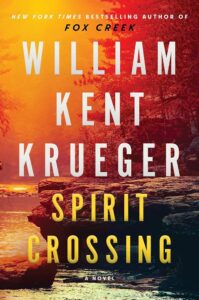Cork O’Connor #20
 I have read every Cork O’Connor book to date, and it’s a series that’s managed to stay fresh and entertaining through it’s now long (and classic) run. The books follow Cork as sheriff in Aurora, Minnesota, as he raises his family, loses his wife, remarries, and leaves law enforcement and becomes a private investigator. However, I don’t think of these books as P.I. novels. I think of them primarily as family novels. I think the combination of Cork’s family story and the action and mystery Krueger brings to the table make these appealing to both male and female readers, something not always true in mystery novels, which tend to skew toward one gender or another in terms of readership.
I have read every Cork O’Connor book to date, and it’s a series that’s managed to stay fresh and entertaining through it’s now long (and classic) run. The books follow Cork as sheriff in Aurora, Minnesota, as he raises his family, loses his wife, remarries, and leaves law enforcement and becomes a private investigator. However, I don’t think of these books as P.I. novels. I think of them primarily as family novels. I think the combination of Cork’s family story and the action and mystery Krueger brings to the table make these appealing to both male and female readers, something not always true in mystery novels, which tend to skew toward one gender or another in terms of readership.
They are also social issue novels, and in this novel, he addresses the issue of missing and murdered indigenous women. Cork, the character, is half Irish and half Ojibwe. It gives him standing when he’s investigating crimes involving natives. Additionally, he has an Ojibwe wife and grandson, and it’s his grandson, Waaboo (Little Rabbit), who figures most prominently in this novel. Waaboo, like his uncle Stephen, has visions and connects with spirits. When the family is out picking blueberries one morning, they find the patch trampled, and when they instead hit Cork’s “secret” patch, Waaboo finds a shallow grave and says he feels fear and sadness. He has to be taken away, but there is indeed a body uncovered when the authorities arrive.
Waaboo insists there was another spirit. The body is assumed to belong to the missing daughter of a politician, but as far as Cork and Waaboo’s father are concerned, the hunt is on for the additional spirit. The body does not turn out to be the politician’s daughter, but it ramps up the investigation, which now includes a complex amalgam of local cops, Reservation police, State police, and FBI. It’s the combination of talent (but mostly Cork’s work with the local sheriff, Marcia Dross) that finally puts a crack in the case.
Waaboo is unfortunately drawing attention for his gifts and he’s taken to stay out in the woods with Henry Meloux, who is helping him to understand them. In typical Krueger fashion, there is much going on: there’s the investigation into the missing girls; there’s Waaboo; and there’s Cork’s daughter Annie, returned home from Guatemala for her brother’s wedding. There’s something bothering her which gradually becomes clear as the book progresses.
This is a well told, moving story (cry meter: three), great mystery, wonderful characters, and Krueger uses his now very large platform to highlight the problem of missing Native American girls. He does it in a way that’s completely integrated into the story – this is after all a novel, not a polemic – but there’s an afterword that gives more statistics and detail. I loved the development of Waaboo’s gift and the way his family is helping him handle it. 20 books into this series, there’s still plenty for Krueger to tell us about Cork O’Connor, his family, and the place where he lives. — Robin Agnew